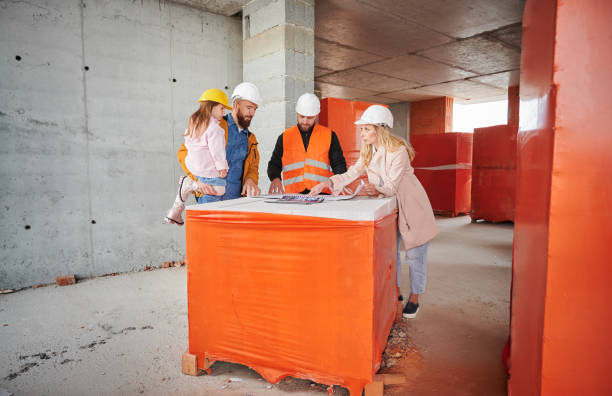Tenant build-out is the process of creating or modifying an existing space to suit the specific needs of a tenant. This construction can involve anything from adding extra bathrooms to tapping into an existing water line. In some cases, a tenant build-out may also involve making changes to the layout of the space. For example, if a tenant plans to use a space for retail purposes, they may need to add shelves or display cases.
The scope and cost of tenant build-out can vary widely depending on the size and complexity of the space involved. For example, a small retail space might only require a few thousand dollars worth of work, while a large office build-out could easily cost five times that amount.
This means it’s important to understand the ins and outs of tenant build-outs if you want the entire process to go smoothly and be completed on time and within budget.
Who is responsible for the costs of a tenant build-out?
The answer to this question depends on the terms of the lease agreement. In most cases, the landlord is responsible for the cost of basic improvements, such as installing new carpeting or painting the walls. However, if a tenant requests more significant changes, such as adding new office space or remodeling the bathroom, the landlord may require the tenant to pay for these improvements.
Sometimes, the landlord may be willing to negotiate who pays for what, so it is always important to ask about these costs upfront. By understanding who is responsible for the costs of a tenant build-out, you can help avoid any unnecessary surprises down the road.
How long does a tenant build-out take
The answer to this question depends on several factors, including the build-out’s size and complexity, workers’ availability, and the weather. However, most experts agree that a typical build-out takes between four and six weeks. This timeframe can be shortened or lengthened depending on the specific circumstances. For example, if the build-out is small and simple, it may only take a few weeks. However, if the build-out is large and complex, it could take several months. In addition, the build-out could take longer than expected if there are delays due to weather or other unforeseen circumstances. As a result, it is difficult to give a definitive answer to the question of how long a tenant build-out will take.
What are some general tips for a successful tenant build-out?
Here are some general tips for a successful tenant build-out project.
Define your needs
The first step is to figure out exactly what you need from your new space. Do a walk-through of your current office and list everything you want to keep, get rid of, or change in the new space. Do you need more meeting rooms? A larger break room? More storage? Once you have a good idea of what you need, you can start looking for spaces that fit those criteria.
Work with a professional
Unless you have experience in commercial real estate, it’s always best to work with a professional who does. They can help you find spaces that match your budget and needs, negotiate leases, and deal with any potential problems.
Get the right team in place
Once you have signed a lease, it’s time to start putting together your tenant build-out team. This should include an architect or designer, a general contractor, and any other specialists that may be needed (like an electrician or plumber). Make sure to interview several candidates for each role and get references before making any decisions.
Create a budget
The tenant build-out contractors from AFS General, Florida say that one of the most important aspects of a successful tenant build-out is staying on budget. Work with your team to create a realistic budget for the project and make sure to track all expenses along the way. If possible, try to get a few different bids for each part of the project so you can compare costs.
Stay organized
Organization is key to any successful project, and a tenant build-out is no different. Create a timeline for the project and make sure everyone involved knows what needs to be done and when. Keep all of your paperwork in one place so you can easily access it if you need to reference anything.
Be prepared for the unexpected
No matter how well you plan, there’s always a chance that something will go wrong during a tenant build-out. Try to anticipate potential problems and have a contingency plan in case they occur. This way, you can deal with them quickly and get back on track.
Communicate with your team
Throughout the entire process, it’s important to communicate openly with your tenant build-out team. If you run into any problems or have any changes that need to be made, make sure to let them know as soon as possible. The sooner they are aware of a problem, the easier it will be to solve.
Be patient
Although you may be eager to move into your new space, it’s important to be patient and wait until the tenant build-out is finished before you start moving in. This way, you can avoid potential disruptions and ensure that everything is just how you want it.
Mistakes to avoid during a tenant build-out project
When undertaking a tenant build-out project, there are many potential mistakes that can be made. Below are some of the most common mistakes to avoid:
Not clearly defining the scope of work
The first mistake to avoid is not clearly defining the scope of work. This can lead to misunderstandings and disagreements later on down the line. Make sure you take the time to sit down with all parties involved and agree on a clear scope of work before starting the project.
Not having a realistic budget
Another mistake that is often made is not having a realistic budget. It is important to remember that tenant build-outs can be costly, so you will need to ensure that you have adequate funding before starting the project.
Not allowing for enough time
Another mistake that can be made is not allowing for enough time. Tenant build-outs can often take longer than expected, so it is important to ensure that you have a realistic timeline.











